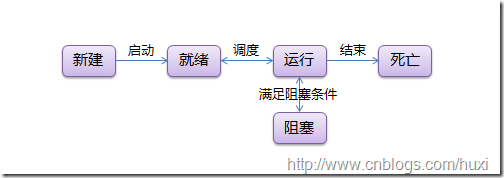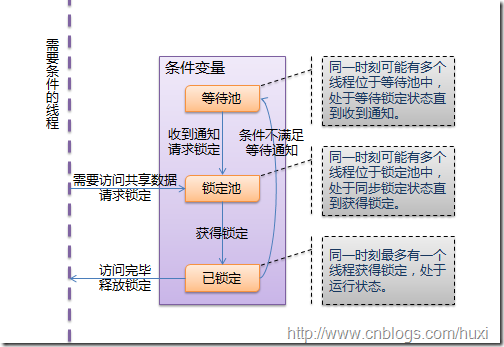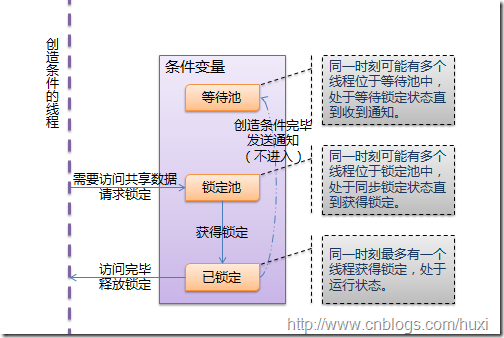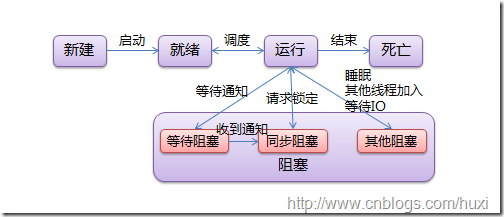程序并行化形式
程序并行化有三种方式, 分别是:并发编程(Concurrent Programming)、 并行编程(Parallel Programming)、
分布式编程(Distributed Programming)
- 并发编程:类似操作系统中的伪并行, 任一时刻只有一个进程占用CPU, 通过调度控制不同的进程在不同时刻访问CPU
- 并行编程:是指在多核环境中,同一时间每个核都可以允许一个进程运行。
- 分布式编程:指在不同机器上同一时刻完成同一项任务, 是物理上的隔离。
并行化的通信方式
- 共享状态:共享进程间的资源,类似于同一进程里所有的线程共享进程的资源一样,在这种通信方式下,对于只读的数据可以不加保护措施,但是对于可写的数据,必须要防止多个进程同时修改这个数据。
- 消息传递:消息传递能够避免上述问题,也能够应用在分布式编程中, 每进行一次消息传递,都会复制一份数据,因此数据一致性得到提升
消息传递优点:
- 数据的一致性大大增强
- 消息能够在本地或者分布式环境中传输
- 解决可伸缩问题并允许不同系统间的相互操作
- 易于实现
并行化存在的问题
死锁
与操作系统中的死锁问题一样,发生在多个进程中每个都需要其他进程的资源,同时又不肯释放自己的资源,导致资源的需求关系形成闭合的环状
饿死
饿死概念与操作系统中的也是一样,指的是某个进程一直得不到自己的资源,无法继续运行。
竞争条件
多个具有不确定性(无法知道何时会到达或执行指定操作)的对象(进程或电子信号),必须要按照时间序列(time sequence)执行,假如这种同步被破坏,那么多个进程会没有顺序地修改同一个变量,导致数据出错
1. 线程(Thread)
python提供thread和threading模。thread是基础的、低等级的、类似于Function作为线程
的运行体。threading是易于使用的基于对象的接口,可以继承Thread对象来实现线程,还提供了
一些线程相关的对象
使用thread的例子
import thread
def worker():
"""thread worker function"""
print 'Worker'
thread.start_new_thread(worker)
使用threading的例子
import threading
def worker():
"""thread worker function"""
print 'Worker'
t = threading.Thread(target=worker)
t.start()
1.1 线程状态
线程有5种状态
新建---(启动)-->就绪<--(调度)-->运行--(结束)-->死亡
(满足阻塞条件)|
阻塞

1.2 线程同步(锁)
线程的优势在于能够同时运行多个任务。 但是当线程需要共享数据时,可能存在数据不同步的问题,为了避免这种情况,需要使用锁。
|
|
线|--(访问共享数据,请求锁定)-->锁定池(同一时刻可能有多个线程位于锁定池中,处于同步锁定状态直到获得锁定)
程| (获得锁定)|
|<--(访问完成,释放锁定)----已锁定(同一时刻最多有一个线程处于锁定状态,处于运行状态)
|
<img src=-“http://images.cnblogs.com/cnblogs_com/huxi/WindowsLiveWriter/Python_11F5/thread_lock_3.png”>
1.3 线程通信(条件变量)
条件变量允许线程比如"set"和"print"在条件不满足的时候(列表为None时)等待,等到条件满足的时候(列表已经创建)发出一个通知,告诉"set" 和"print"条件已经有了,你们该起床干活了;然后"set"和"print"才继续运行


1.4 线程运行和阻塞状态

阻塞有三种状态:
- 同步阻塞:指处于竞争锁定的状态,线程请求锁定时将进入这个状态, 成功获得锁定后恢复到运行状态
- 等待阻塞:指等待其他线程通知的状态,线程获得条件锁定后, 调用“等待”将进入这个状态,线程发出通知,线程将进入同步阻塞状态,再次竞争条件锁定
- 其他阻塞:指调用time.sleep()、anotherthread.join()或等待IO时的阻塞,此状态下的线程不会释放已获得的锁定
thread
thread 模块提供的其他方法:
- thread.interrupt_main(): 在其他线程中终止主线程。
- thread.get_ident(): 获得一个代表当前线程的魔法数字,常用于从一个字典中获得线程相关的数据。这个数字本身没有任何含义,并且当线程结束后会被新线程复用。
- thread还提供了一个ThreadLocal类用于管理线程相关的数据,名为 thread._local,threading中引用了这个类。
由于thread提供的线程功能不多,无法在主线程结束后继续运行,不提供条件变量等等原因,一般不使用thread模块,这里就不多介绍了。
# encoding: UTF-8
import thread
import time
# 一个用于在线程中执行的函数
def func():
for i in range(5):
print 'func'
time.sleep(1)
# 结束当前线程
# 这个方法与thread.exit_thread()等价
thread.exit() # 当func返回时,线程同样会结束
# 启动一个线程,线程立即开始运行
# 这个方法与thread.start_new_thread()等价
# 第一个参数是方法,第二个参数是方法的参数
thread.start_new(func, ()) # 方法没有参数时需要传入空tuple
# 创建一个锁(LockType,不能直接实例化)
# 这个方法与thread.allocate_lock()等价
lock = thread.allocate()
# 判断锁是锁定状态还是释放状态
print lock.locked()
# 锁通常用于控制对共享资源的访问
count = 0
# 获得锁,成功获得锁定后返回True
# 可选的timeout参数不填时将一直阻塞直到获得锁定
# 否则超时后将返回False
if lock.acquire():
count += 1
# 释放锁
lock.release()
# thread模块提供的线程都将在主线程结束后同时结束
time.sleep(6)
threading
threading基于Java的线程模型设计。锁(Lock)和条件变量(Condition)在Java中是对象的基本行为(每一个对象都自带了锁和条件变量),而在Python中则是独立的对象。Python Thread提供了Java Thread的行为的子集;没有优先级、线程组,线程也不能被停止、暂停、恢复、中断。Java Thread中的部分被Python实现了的静态方法在threading中以模块方法的形式提供。
- threading.currentThread(): 返回当前的线程变量
- threading.enumerate(): 返回一个包含正在运行的线程的list。正在运行指线程启动后、结束前,不包括启动前和终止后的线程。
- threading.activeCount(): 返回正在运行的线程数量,与len(threading.enumerate())有相同的结果。
threading模块提供的类:Thread, Lock, Rlock, Condition, [Bounded]Semaphore, Event, Timer, local.
Thread
Thread是线程类,与Java类似,有两种使用方法,直接传入要运行的方法或从Thread继承并覆盖run():
# encoding: UTF-8
import threading
# 方法1:将要执行的方法作为参数传给Thread的构造方法
def func():
print 'func() passed to Thread'
t = threading.Thread(target=func)
t.start()
# 方法2:从Thread继承,并重写run()
class MyThread(threading.Thread):
def run(self):
print 'MyThread extended from Thread'
t = MyThread()
t.start()
构造方法:
- Thread(group=None, target=None, name=None, args=(), kwargs={})
- group: 线程组,目前还没有实现,库引用中提示必须是None;
- target: 要执行的方法;
- name: 线程名;
- args/kwargs: 要传入方法的参数。
实例方法:
- isAlive(): 返回线程是否在运行。正在运行指启动后、终止前。
- get/setName(name): 获取/设置线程名。
- is/setDaemon(bool): 获取/设置是否守护线程。初始值从创建该线程的线程继承。当没有非守护线程仍在运行时,程序将终止。
- start(): 启动线程。
- join([timeout]): 阻塞当前上下文环境的线程,直到调用此方法的线程终止或到达指定的timeout(可选参数)。
(join方法,如果一个线程或者一个函数在执行过程中要调用另外一个线程,并且待到其完成以后才能接着执行,那么在调用这个线程时可以使用被调用线程的join方法。)
# encoding: UTF-8
import threading
import time
def context(tJoin):
print 'in threadContext.'
tJoin.start()
# 将阻塞tContext直到threadJoin终止。
tJoin.join()
# tJoin终止后继续执行。
print 'out threadContext.'
def join():
print 'in threadJoin.'
time.sleep(1)
print 'out threadJoin.'
tJoin = threading.Thread(target=join)
tContext = threading.Thread(target=context, args=(tJoin,))
tContext.start()
Lock
Lock(指令锁)是可用的最低级的同步指令。Lock处于锁定状态时,不被特定的线程拥有。Lock包含两种状态——锁定和非锁定,以及两个基本的方法
可以认为Lock有一个锁定池,当线程请求锁定时,将线程至于池中,直到获得锁定后出池。池中的线程处于状态图中的同步阻塞状态。
构造方法:
- Lock()
实例方法:
- acquire([timeout]): 使线程进入同步阻塞状态,尝试获得锁定。
- release(): 释放锁。使用前线程必须已获得锁定,否则将抛出异常。
import threading # 导入threading模块
import time # 导入time模块
class mythread(threading.Thread): # 通过继承创建类
def __init__(self,threadname): # 初始化方法
threading.Thread.__init__(self,name = threadname)
def run(self): # 重载run方法
global x # 使用global表明x为全局变量
lock.acquire() # 调用lock的acquire方法
for i in range(3):
x = x + 1
time.sleep(2) # 调用sleep函数,让线程休眠5秒
print x
lock.release() # 调用lock的release方法
lock = threading.Lock() # 类实例化
tl = [] # 定义列表
for i in range(10):
t = mythread(str(i)) # 类实例化
tl.append(t) # 将类对象添加到列表中
x=0 # 将x赋值为0
for i in tl:
i.start() # 依次运行线程
RLock
RLock(可重入锁)是一个可以被同一个线程请求多次的同步指令。RLock使用了“拥有的线程”和“递归等级”的概念,处于锁定状态时,RLock被某个线程拥有。拥有RLock的线程可以再次调用acquire(),释放锁时需要调用release()相同次数。
RLock包含一个锁定池和一个初始值为0的计数器,每次成功调用 acquire()/release(),计数器将+1/-1,为0时锁处于未锁定状态。
构造方法:
- RLock()
实例方法:
- acquire([timeout])/release(): 跟Lock差不多。
# encoding: UTF-8
import threading
import time
rlock = threading.RLock()
def func():
# 第一次请求锁定
print '%s acquire lock...' % threading.currentThread().getName()
if rlock.acquire():
print '%s get the lock.' % threading.currentThread().getName()
time.sleep(2)
# 第二次请求锁定
print '%s acquire lock again...' % threading.currentThread().getName()
if rlock.acquire():
print '%s get the lock.' % threading.currentThread().getName()
time.sleep(2)
# 第一次释放锁
print '%s release lock...' % threading.currentThread().getName()
rlock.release()
time.sleep(2)
# 第二次释放锁
print '%s release lock...' % threading.currentThread().getName()
rlock.release()
t1 = threading.Thread(target=func)
t2 = threading.Thread(target=func)
t3 = threading.Thread(target=func)
t1.start()
t2.start()
t3.start()
Condition
Condition(条件变量)通常与一个锁关联。需要在多个Contidion中共享一个锁时,可以传递一个Lock/RLock实例给构造方法,否则它将自己生成一个RLock实例。
可以认为,除了Lock带有的锁定池外,Condition还包含一个等待池,池中的线程处于状态图中的等待阻塞状态,直到另一个线程调用notify()/notifyAll()通知;得到通知后线程进入锁定池等待锁定。
构造方法:
- Condition([lock/rlock])
实例方法:
- acquire([timeout])/release(): 调用关联的锁的相应方法。
- wait([timeout]): 调用这个方法将使线程进入Condition的等待池等待通知,并释放锁。使用前线程必须已获得锁定,否则将抛出异常。
- notify(): 调用这个方法将从等待池挑选一个线程并通知,收到通知的线程将自动调用acquire()尝试获得锁定(进入锁定池);其他线程仍然在等待池中。调用这个方法不会释放锁定。使用前线程必须已获得锁定,否则将抛出异常。
- notifyAll(): 调用这个方法将通知等待池中所有的线程,这些线程都将进入锁定池尝试获得锁定。调用这个方法不会释放锁定。使用前线程必须已获得锁定,否则将抛出异常。
# encoding: UTF-8
import threading
import time
# 商品
product = None
# 条件变量
con = threading.Condition()
# 生产者方法
def produce():
global product
if con.acquire():
while True:
if product is None:
print 'produce...'
product = 'anything'
# 通知消费者,商品已经生产
con.notify()
# 等待通知
con.wait()
time.sleep(2)
# 消费者方法
def consume():
global product
if con.acquire():
while True:
if product is not None:
print 'consume...'
product = None
# 通知生产者,商品已经没了
con.notify()
# 等待通知
con.wait()
time.sleep(2)
t1 = threading.Thread(target=produce)
t2 = threading.Thread(target=consume)
t2.start()
t1.start()
Semaphore/BoundedSemaphore
Semaphore管理一个内置的计数器,每当调用acquire()时-1,调用release() 时+1。计数器不能小于0;当计数器为0时,acquire()将阻塞线程至同步锁定状态,直到其他线程调用release()。
基于这个特点,Semaphore经常用来同步一些有“访客上限”的对象,比如连接池。
BoundedSemaphore 与Semaphore的唯一区别在于前者将在调用release()时检查计数器的值是否超过了计数器的初始值,如果超过了将抛出一个异常。
构造方法:
- Semaphore(value=1): value是计数器的初始值。
实例方法:
- acquire([timeout]): 请求Semaphore。如果计数器为0,将阻塞线程至同步阻塞状态;否则将计数器-1并立即返回。
- release(): 释放Semaphore,将计数器+1,如果使用BoundedSemaphore,还将进行释放次数检查。release()方法不检查线程是否已获得 Semaphore。
# encoding: UTF-8
import threading
import time
# 计数器初值为2
semaphore = threading.Semaphore(2)
def func():
# 请求Semaphore,成功后计数器-1;计数器为0时阻塞
print '%s acquire semaphore...' % threading.currentThread().getName()
if semaphore.acquire():
print '%s get semaphore' % threading.currentThread().getName()
time.sleep(4)
# 释放Semaphore,计数器+1
print '%s release semaphore' % threading.currentThread().getName()
semaphore.release()
t1 = threading.Thread(target=func)
t2 = threading.Thread(target=func)
t3 = threading.Thread(target=func)
t4 = threading.Thread(target=func)
t1.start()
t2.start()
t3.start()
t4.start()
time.sleep(2)
# 没有获得semaphore的主线程也可以调用release
# 若使用BoundedSemaphore,t4释放semaphore时将抛出异常
print 'MainThread release semaphore without acquire'
semaphore.release()
Event
Event(事件)是最简单的线程通信机制之一:一个线程通知事件,其他线程等待事件。Event内置了一个初始为False的标志,当调用set()时设为True,调用clear()时重置为 False。wait()将阻塞线程至等待阻塞状态。
Event其实就是一个简化版的 Condition。Event没有锁,无法使线程进入同步阻塞状态。
构造方法:
- Event()
实例方法:
- isSet(): 当内置标志为True时返回True。
- set(): 将标志设为True,并通知所有处于等待阻塞状态的线程恢复运行状态。
- clear(): 将标志设为False。
- wait([timeout]): 如果标志为True将立即返回,否则阻塞线程至等待阻塞状态,等待其他线程调用set()。
# encoding: UTF-8
import threading
import time
event = threading.Event()
def func():
# 等待事件,进入等待阻塞状态
print '%s wait for event...' % threading.currentThread().getName()
event.wait()
# 收到事件后进入运行状态
print '%s recv event.' % threading.currentThread().getName()
t1 = threading.Thread(target=func)
t2 = threading.Thread(target=func)
t1.start()
t2.start()
time.sleep(2)
# 发送事件通知
print 'MainThread set event.'
event.set()
Timer
Timer(定时器)是Thread的派生类,用于在指定时间后调用一个方法。
构造方法:
- Timer(interval, function, args=[], kwargs={})
- interval: 指定的时间
- function: 要执行的方法
- args/kwargs: 方法的参数
实例方法:
- Timer从Thread派生,没有增加实例方法。
# encoding: UTF-8
import threading
def func():
print 'hello timer!'
timer = threading.Timer(5, func)
timer.start()
local
local是一个小写字母开头的类,用于管理 thread-local(线程局部的)数据。对于同一个local,线程无法访问其他线程设置的属性;线程设置的属性不会被其他线程设置的同名属性替换。
可以把local看成是一个“线程-属性字典”的字典,local封装了从自身使用线程作为 key检索对应的属性字典、再使用属性名作为key检索属性值的细节。
# encoding: UTF-8
import threading
local = threading.local()
local.tname = 'main'
def func():
local.tname = 'notmain'
print local.tname
t1 = threading.Thread(target=func)
t1.start()
t1.join()
print local.tname
熟练掌握Thread、Lock、Condition就可以应对绝大多数需要使用线程的场合,某些情况下local也是非常有用的东西。本文的最后使用这几个类展示线程基础中提到的场景:
# encoding: UTF-8
import threading
alist = None
condition = threading.Condition()
def doSet():
if condition.acquire():
while alist is None:
condition.wait()
for i in range(len(alist))[::-1]:
alist[i] = 1
condition.release()
def doPrint():
if condition.acquire():
while alist is None:
condition.wait()
for i in alist:
print i,
print
condition.release()
def doCreate():
global alist
if condition.acquire():
if alist is None:
alist = [0 for i in range(10)]
condition.notifyAll()
condition.release()
tset = threading.Thread(target=doSet,name='tset')
tprint = threading.Thread(target=doPrint,name='tprint')
tcreate = threading.Thread(target=doCreate,name='tcreate')
tset.start()
tprint.start()
tcreate.start()
2. 进程(Process)
Python由于存在GIL的问题,比较好的并行方式是多进程,使用多进程要考虑机器配置和资源开销
Unix/Linux操作系统提供了一个fork()系统调用,它非常特殊。普通的函数调用,调用一次,返回一次,但是fork()调用一次,返回两次,因为操作系统自动把当前进程(称为父进程)复制了一份(称为子进程),然后,分别在父进程和子进程内返回。
子进程永远返回0,而父进程返回子进程的ID。这样做的理由是,一个父进程可以fork出很多子进程,所以,父进程要记下每个子进程的ID,而子进程只需要调用getppid()就可以拿到父进程的ID。
multiprocessing
该模块为在子进程中运行任务、通信和共享数据,以及执行各种形式的同步提供支持。接口风格与threading模块类似,但要注意进程之间没有任何共享状态。
多进程处理的一般建议
- 确保进程之间传递的所有数据都能够序列化
- 避免使用共享数据,尽可能使用消息传递和队列。使用消息传递时,不必过于担心同步、锁定和其他问题。当进程的数量增长时,它往往还能提供更好的扩展
- 在必须行在单独进程中的函数内部,不要使用全局变量而应当显式地传递参数
- 尽量不要在同一个程序中混合使用线程和多线程处理
- 特別要注意关闭进程的方式。一般而言,需要显式地关闭进程,并使用一种定义良好的终止模式,而不要仅仅依赖于垃圾收集或者被迫使用terminate ()操作强制终止子进程
- 管理器和代理的使用与分布式计算中的多个概念密切相关(例如,分布式对象)
- 尽管此模块可以工作在Windows上,但还是应该仔细阅读官方文档中的各种微妙细节
- 最重要的一点是:尽量让事情变得简单
from multiprocessing import Process
import os
# 子进程要执行的代码
def run_proc(name):
print 'Run child process %s (%s)...' % (name, os.getpid())
if __name__=='__main__':
print 'Parent process %s.' % os.getpid()
p = Process(target=run_proc, args=('test',))
print 'Process will start.'
p.start()
p.join()
print 'Process end.'
####### 进程间通信
multiprocessing模块支持进程间通信的两种主要形式:管道和队列,这两种方法都是使用消息传递实现的。






















 6983
6983











 被折叠的 条评论
为什么被折叠?
被折叠的 条评论
为什么被折叠?








